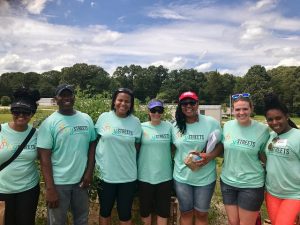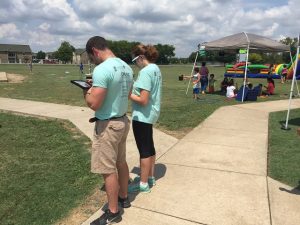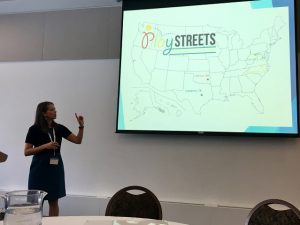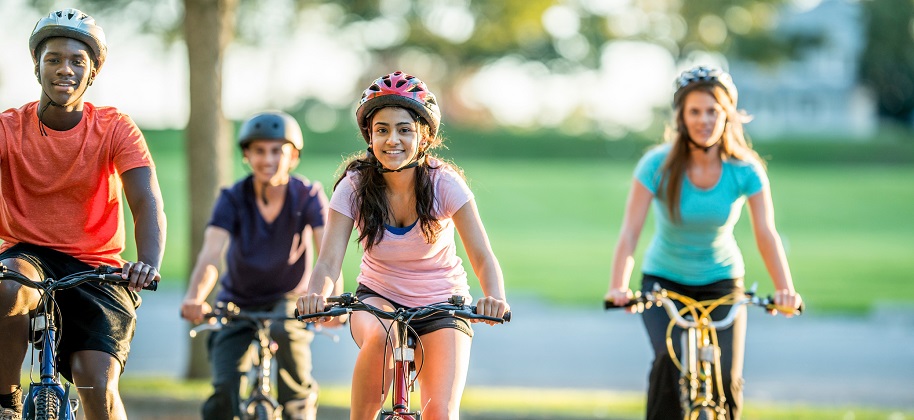Exploring How Play Streets Impact Children’s Physical Activity
By: Keshia Pollack Porter, PhD, MPH, Johns Hopkins Bloomberg School of Public Health and Renée Umstattd Meyer, PhD, MCHES, Baylor University
 Play Streets! Have you heard of them? Well, Play Streets are temporary street closures that allow for an area to be used for physical activity with the earliest of these events dating back to the 1920s. With support from the Physical Activity Research Center (PARC), we have been studying how Play Streets are organized and their impacts on kids, families, and communities in rural settings. To get the word out about our work, in February our team gave three presentations at the 2018 Active Living Research Conference in Banff, Canada and in March two presentations at the 2018 American Academy of Health Behavior Annual Scientific Meeting in Portland, Oregon. Our presentations highlighted initial findings from our study.
Play Streets! Have you heard of them? Well, Play Streets are temporary street closures that allow for an area to be used for physical activity with the earliest of these events dating back to the 1920s. With support from the Physical Activity Research Center (PARC), we have been studying how Play Streets are organized and their impacts on kids, families, and communities in rural settings. To get the word out about our work, in February our team gave three presentations at the 2018 Active Living Research Conference in Banff, Canada and in March two presentations at the 2018 American Academy of Health Behavior Annual Scientific Meeting in Portland, Oregon. Our presentations highlighted initial findings from our study.
What do we know about Play Streets?
 Two of our presentations described two systematic reviews of the existing literature regarding Play Streets and their impacts on play for children, physical activity levels, and communities. We examined 13 peer review articles (from 180 abstracts reviewed in the academic literature) that met inclusion criteria for the review. Six of these studies were from the U.S. and 10 out of the 13 studies did not measure physical activity outcomes. We also reviewed the non-academic literature on Play Streets. The 36 documents that we reviewed (out of 247 documents) were from the U.S., U.K., Canada, Australia, and Chile. Nearly all (34 out of the 36 documents) did not measure physical activity outcomes.
Two of our presentations described two systematic reviews of the existing literature regarding Play Streets and their impacts on play for children, physical activity levels, and communities. We examined 13 peer review articles (from 180 abstracts reviewed in the academic literature) that met inclusion criteria for the review. Six of these studies were from the U.S. and 10 out of the 13 studies did not measure physical activity outcomes. We also reviewed the non-academic literature on Play Streets. The 36 documents that we reviewed (out of 247 documents) were from the U.S., U.K., Canada, Australia, and Chile. Nearly all (34 out of the 36 documents) did not measure physical activity outcomes.
The main findings from the literature include:
- While most of the documents that we reviewed did not measure physical activity, Play Streets were described as safe places for children to play because of reduced traffic and increased supervision.
- Games, activities, and equipment were provided for children at Play Streets, most commonly including cycling, dancing, and walking.
- Play Streets strengthen communities and increase social interactions.
- Some residents complained about traffic detours and noise from Play Streets events.
- Some organizations hope that Play Streets can decrease crime and violence among adolescents.
What do we know about Play Streets in rural communities?
 Our other presentations examined how Play Streets impact the physical activity of youth in rural communities. We were excited for these preliminary findings because they are from the first ever investigation of Play Streets in rural communities. In our study, four different rural communities received mini-grants to each host 4 Play Streets during the summer of 2017. We used a popular and valid tool for observing physical activity called SOPARC (System for Observing Play and Recreation in Communities). SOPARC has mainly been used to observe physical activity in permanent spaces such as parks, and we adapted it to temporary spaces, which are the essence of Play Streets. Most notable about the use of SOPARC for Play Streets was that during the course of a Play Street, spaces had the potential to appear and/or disappear depending on how children were using the different areas! We are still analyzing these data, but what we have seen so far, is that across the 350+ children who wore pedometers at the Play Streets, another way to measure physical activity, many of them were active at the Play Street.
Our other presentations examined how Play Streets impact the physical activity of youth in rural communities. We were excited for these preliminary findings because they are from the first ever investigation of Play Streets in rural communities. In our study, four different rural communities received mini-grants to each host 4 Play Streets during the summer of 2017. We used a popular and valid tool for observing physical activity called SOPARC (System for Observing Play and Recreation in Communities). SOPARC has mainly been used to observe physical activity in permanent spaces such as parks, and we adapted it to temporary spaces, which are the essence of Play Streets. Most notable about the use of SOPARC for Play Streets was that during the course of a Play Street, spaces had the potential to appear and/or disappear depending on how children were using the different areas! We are still analyzing these data, but what we have seen so far, is that across the 350+ children who wore pedometers at the Play Streets, another way to measure physical activity, many of them were active at the Play Street.
Based on existing literature, Play Streets seem to have positive impacts on children’s opportunities for general play and their physical activity levels, as well as on community safety and relations. Our data also suggest that Play Streets are a good way to get kids active in rural communities. We look forward to learning more about the impacts of Play Streets on children and families, in addition to important lessons regarding how communities should organize and run them.
